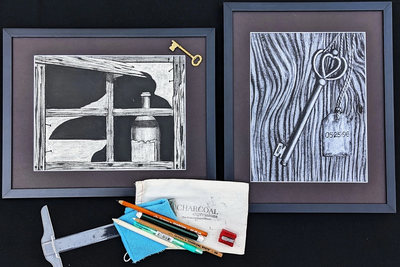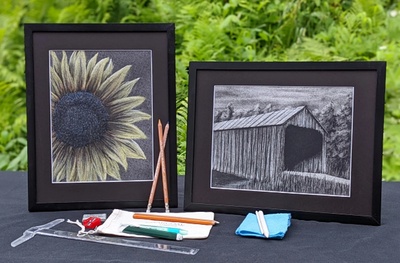Charcoal Drawing Ideas for Curious Beginners
Updated by Katie King
Over the last few years, many of us have found joy in new hobbies: crafting, baking, and, of course, drawing. But starting a new hobby can oftentimes be overwhelming and expensive with a host of new information, new techniques, and pricey supplies. However, there are many artistic outlets that don’t require the same level of financial and intellectual buy-in as, say, deciding to start sewing your own clothes. A recent favorite of ours here at Cratejoy has been drawing with charcoal. Read on to find out why.
Why Draw with Charcoal?
If you are new to sketching, or making art in general, charcoal can be a great option . Unlike an extensive paint set or working with pastels, you only need a handful of supplies to create dynamic drawings. This limited set of supplies helps to keep costs down while not overwhelming a newbie with a series of endless tools.
In order to get the most out of a charcoal drawing set , you’ll typically rely on a charcoal block for softer shading and coloring of large areas, as well as a few charcoal pencils for creating harder lines. You’ll also need a pencil sharpener, especially if you want to create sketches with defined edges and lines.
Lastly, you’ll need paper designed for drawing with charcoal (although you can also use watercolor paper if you already have that on hand). The most important thing is that you don’t use smooth paper like lined sheet paper or printer paper: the charcoal needs to be able to stay on the surface, meaning the paper needs to be rough enough to grip the ash.
If you want your sketches to look amazing, you’ll also want blending tools, as using your fingers to change the shape and density of the ash will transfer unwanted oils to your drawing as well as create a bit of mess. However, if you aren’t wanting to spend more on supplies, you can always use tissues, toilet paper, or any clean old paintbrushes you might have laying around the house.

What’s Different About Drawing with Charcoal?
Generally speaking, “charcoal” can be made out of any burnt organic material. However, the charcoal you encounter at the art store will most likely be derived from compacted, charred wood. What’s more, not all types of charcoal are the same: it comes in a variety of shapes and hardness grades depending on your drawing needs.
Unlike other types of drawing or painting activities , charcoal drawings are inherently black and white. They rely on shading, depth, and the interplay between light and dark rather than the spectrum of color. As such, they are often easier to approach than figuring out how to blend different shades of red to get a perfect pink.
However, just because you’re not dealing in color doesn’t mean charcoal drawings are simple or one-note. They can be expressionistic and gentle, or they can be extremely detailed and sharp. Because of this, charcoal is often the first material art students work with in technical drawing classes.

Where to Begin Drawing with Charcoal?
So, you’ve accumulated all of your supplies and you’re ready to begin your charcoal-drawing journey. Now, what to draw?
A Simple Still Life
When just starting out, we’d recommend beginning with a few still-life drawings—the simpler, the better. These easy studies will help you to understand how the different types of charcoal and your various other tools feel in your hands, on paper, and how they work together. Static objects will also help you to understand shading and light, which are foundational to charcoal sketches.
Take a look at what you have on hand in your home. A few vases? Fruit? Even a bouncing ball or marble can make an interesting and dynamic still-life drawing.
A Complicated Still Life
Once you feel like you’ve mastered the basics of your simple still-life, use the same objects to create a more complicated picture. Rearrange them, add more objects, overlap them, or even draw them at different times of day, in a different light, or with different angles. Continuing to draw the same objects over and over again will help you to understand the interplay between light and shadows and how best to capture that with different charcoal tools.
A Nature Scene
Feeling confident drawing the object in your home? Then let’s pack it up and take it outside. Although nature scenes can sometimes feel overwhelming to draw, like you need to capture every blade of grass around you, pick one object—a tree, a flower, a singular plant—and do your best to create the detail and movement it expresses.















